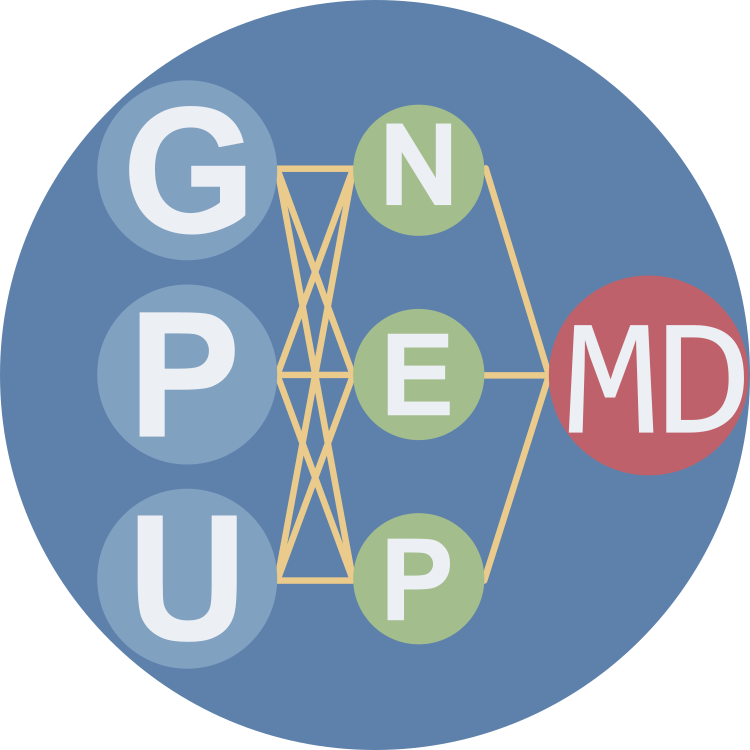GPUMDstands for Graphics Processing Units Molecular Dynamics. It is a general-purpose molecular dynamics (MD) code fully implemented on graphics processing units (GPUs).- Force evaluation for many-body potentials has been significantly accelerated by using GPUs [1], thanks to a set of simple expressions for force, virial stress, and heat current derived in Refs. [2, 3].
- Apart from being highly efficient, another unique feature of GPUMD is that it has useful utilities to study heat transport [2, 3, 4, 5].
- It can run MD simulations with the machine-learning based force constant potential (FCP) [6].
- It can train the NEP machine-learning potential [7, 8] and run MD simulations with it. See this nep-data Gitlab repo for all the published NEP potentials and the related training/testing data.
- You need to have a GPU card with compute capability no less than 3.5 and a
CUDAtoolkit no older thanCUDA9.0. - Works for both Linux (with GCC) and Windows (with MSVC) operating systems.
- Go to the
srcdirectory and typemake. When the compilation finishes, two executables,gpumdandnep, will be generated in thesrcdirectory.
- See the
examples/readme.mdfile.
- We only maintain the online manual now: https://gpumd.zheyongfan.org
-
You can use the following link to subscribe and unsubscribe the mailing list: https://www.freelists.org/list/gpumd
-
To post a question, you can send an email to gpumd(at)freelists.org
-
Here is the archive (public): https://www.freelists.org/archive/gpumd/
- One of the developers, Alexander J. Gabourie, has written a Python package
thermofor pre-processing and post-processing data related toGPUMD. Here is the link: https://github.com/AlexGabourie/thermo (This will be changed to a new packagegpyumd) - One of the developers, Junjie Wang, has written a Python package
PyNEPthat can be used to compute various quantities related to the NEP model. It uses a C++ NEP implementation (https://github.com/brucefan1983/GPUMD/tree/master/tools/nep_related/nep_cpu) as the backend. Here is the link: https://github.com/bigd4/PyNEP. So GPU and CUDA are not needed forPyNEP.
- Before the first release, GPUMD was developed by Zheyong Fan, with help from Ville Vierimaa (Previously Aalto University) and Mikko Ervasti (Previously Aalto University) and supervision from Ari Harju (Previously Aalto University).
- Below is the full list of contributors starting from the first release.
| Name | contact |
|---|---|
| Zheyong Fan | https://github.com/brucefan1983 |
| Alexander J. Gabourie | https://github.com/AlexGabourie |
| Ke Xu | https://github.com/Kick-H |
| Ting Liang | https://github.com/Tingliangstu |
| Jiahui Liu | https://github.com/Jonsnow-willow |
| Penghua Ying | https://github.com/hityingph |
| Real Name ? | https://github.com/Lazemare |
| Yanzhou Wang | https://github.com/Yanzhou-Wang |
| Rui Zhao | https://github.com/grtheaory |
| Eric Lindgren | https://github.com/elindgren |
| Junjie Wang | https://github.com/bigd4 |
| Yong Wang | https://github.com/AmbroseWong |
- If you use
GPUMDin your published work, we kindly ask you to cite the following paper which describes the central algorithms used inGPUMD:
[1] Zheyong Fan, Wei Chen, Ville Vierimaa, and Ari Harju. Efficient molecular dynamics simulations with many-body potentials on graphics processing units. Computer Physics Communications 218, 10 (2017). https://doi.org/10.1016/j.cpc.2017.05.003
- If you want to cite a link to the GPUMD code you can cite the current Github page: https://github.com/brucefan1983/GPUMD.
- However, if the journal does not accept this citation, you can check the Zenodo page of GPUMD (https://zenodo.org/record/4037256#.X2jkqWj7SUk) and cite the version you used. Each version has a unique DOI, which is very suitable for citation. You can write the authors of this reference to "GPUMD developers".
- If your work involves using heat current and virial stress formulas as implemented in
GPUMD, the following two papers can be cited:
[2] Zheyong Fan, Luiz Felipe C. Pereira, Hui-Qiong Wang, Jin-Cheng Zheng, Davide Donadio, and Ari Harju. Force and heat current formulas for many-body potentials in molecular dynamics simulations with applications to thermal conductivity calculations. Phys. Rev. B 92, 094301, (2015). https://doi.org/10.1103/PhysRevB.92.094301
[3] Alexander J. Gabourie, Zheyong Fan, Tapio Ala-Nissila, Eric Pop, Spectral Decomposition of Thermal Conductivity: Comparing Velocity Decomposition Methods in Homogeneous Molecular Dynamics Simulations, Phys. Rev. B 103, 205421 (2021).
- You can cite the following paper if you use
GPUMDto study heat transport using the in-out decomposition for 2D materials and/or the spectral decomposition method as described in it:
[4] Zheyong Fan, Luiz Felipe C. Pereira, Petri Hirvonen, Mikko M. Ervasti, Ken R. Elder, Davide Donadio, Tapio Ala-Nissila, and Ari Harju. Thermal conductivity decomposition in two-dimensional materials: Application to graphene. Phys. Rev. B 95, 144309, (2017). https://doi.org/10.1103/PhysRevB.95.144309
- You can cite the following paper if you use
GPUMDto study heat transport using the HNEMD method and the associated spectral decomposition method:
[5] Z. Fan, H. Dong, A. Harju, T. Ala-Nissila, Homogeneous nonequilibrium molecular dynamics method for heat transport and spectral decomposition with many-body potentials, Phys. Rev. B 99, 064308 (2019). https://doi.org/10.1103/PhysRevB.99.064308
- If you use the force constant potential (FCP), you can cite the following paper:
[6] Joakim Brorsson, Arsalan Hashemi, Zheyong Fan, Erik Fransson, Fredrik Eriksson, Tapio Ala-Nissila, Arkady V. Krasheninnikov, Hannu-Pekka Komsa, Paul Erhart, Efficient calculation of the lattice thermal conductivity by atomistic simulations with ab-initio accuracy, Advanced Theory and Simulations 4, 2100217 (2021).
- If you train or use a NEP potential, you can cite the following papers:
[7] Zheyong Fan, Zezhu Zeng, Cunzhi Zhang, Yanzhou Wang, Keke Song, Haikuan Dong, Yue Chen, and Tapio Ala-Nissila, Neuroevolution machine learning potentials: Combining high accuracy and low cost in atomistic simulations and application to heat transport, Phys. Rev. B. 104, 104309 (2021).
[8] Zheyong Fan, Improving the accuracy of the neuroevolution machine learning potentials for multi-component systems, Journal of Physics: Condensed Matter 34 125902 (2022).
